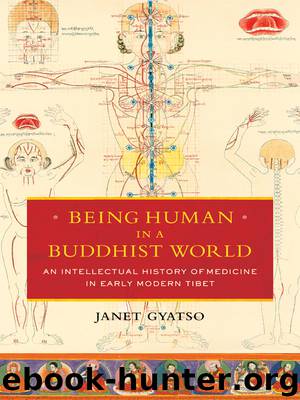Being Human in a Buddhist World by Janet Gyatso

Author:Janet Gyatso
Language: eng
Format: epub
Tags: REL007050, Religion/Buddhism/Tibetan, HIS008000, History/Asia/China
Publisher: Columbia University Press
Published: 2015-02-02T16:00:00+00:00
Coda.4 The central figures of plates 9 and 12, showing the tantric channels.
The captions for the main figure of plate 9 only point to the bloodletting and vulnerable vessels. But the figure is also meant to illustrate the growth channels and the channels of being, although these are only mentioned in the colophon at the bottom of the painting, keyed roughly to alphabetic letters on the figure.22 This colophon shows its indebtedness once again to Zurkharwa: “the three growth channels are explained in the tantras to be produced by the three tantric channels, the central one, roma, and kyangma.” The colophon also adds that the petals of the matrices of the channels of being “ramify” from the three tantric channels—also familiar language from Ancestors’ Advice. Neither of these points appears to be illustrated, however. Nor is a further claim in the colophon that the figure shows the way the black vital channel mixes with the tantric central channel from the front and the white one from the back.23 But the overall image certainly shows what look to be the three tantric channels in the adult body, with a straight channel in the center and the two side channels converging at each of the cakras, the standard picture in tantric literature. In fact, toward the end of the colophon that continues on plate 10, it is mentioned, seemingly as an afterthought, that ro and kyang are pictured here, running on the right and left, with their “intrinsic marking colors of red and white.”24 This seems to say that the tantric channels indicate themselves. In any event, no caption labels them, as if there was some hesitation about being too overt in pointing to them so baldly.
The second instance in which the tantric channels are pictured in the mature body is on plate 12. Here the main image has ostensibly to do with the three kinds of life channels, i.e., the last of the four categories of channels, which Zurkharwa denied were channels at all. The plate includes captions that refer to all three life channels, but it is not at all clear what they are pointing to or how these life channels are illustrated. The figure also seems to be presenting again the standard tantric picture of the central channel, roma and kyangma. A caption toward the top of the plate acknowledges this, averring that ro, kyang, and the central channel are merely pointed out here, without detailed analysis. Noncommittally, this caption does not point to anything. The colophon acknowledges the figure’s visual reference to the tantric channels once more, again noncommittally saying that the three channels are illustrated only roughly here.25
In short, we can see that the Desi and his artists endeavored to portray the tantric channels, but were evasive in doing so. They do not picture them on the plates devoted to the connecting channels or the organs or bones of the body, as Zurkharwa’s discussion would certainly have cautioned them against.26 But they did render them on the
Download
This site does not store any files on its server. We only index and link to content provided by other sites. Please contact the content providers to delete copyright contents if any and email us, we'll remove relevant links or contents immediately.
The Lost Art of Listening by Michael P. Nichols(6464)
Why I Am Not A Calvinist by Dr. Peter S. Ruckman(3767)
The Rosicrucians by Christopher McIntosh(3047)
Wicca: a guide for the solitary practitioner by Scott Cunningham(2702)
Signature in the Cell: DNA and the Evidence for Intelligent Design by Stephen C. Meyer(2496)
Real Sex by Lauren F. Winner(2467)
The Holy Spirit by Billy Graham(2408)
To Light a Sacred Flame by Silver RavenWolf(2350)
The End of Faith by Sam Harris(2280)
The Gnostic Gospels by Pagels Elaine(2023)
Nine Parts of Desire by Geraldine Brooks(2002)
Waking Up by Sam Harris(1953)
Heavens on Earth by Michael Shermer(1951)
Devil, The by Almond Philip C(1896)
Jesus by Paul Johnson(1882)
The God delusion by Richard Dawkins(1843)
Kundalini by Gopi Krishna(1822)
Chosen by God by R. C. Sproul(1755)
The Nature of Consciousness by Rupert Spira(1688)
